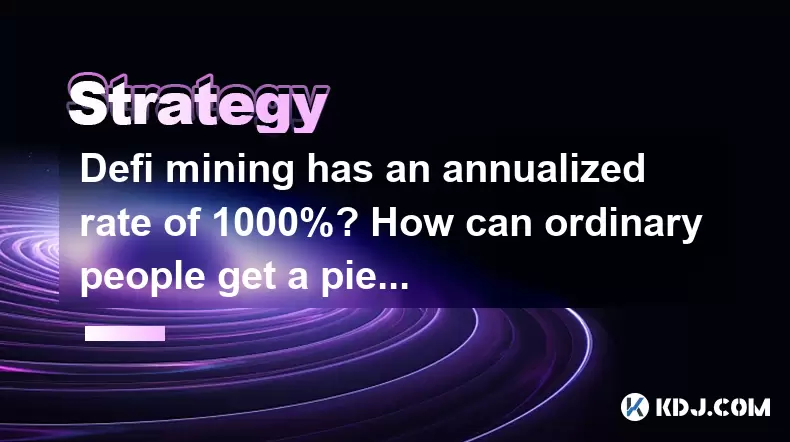-
 bitcoin
bitcoin $118548.520763 USD
3.67% -
 ethereum
ethereum $4352.564943 USD
4.79% -
 xrp
xrp $2.964058 USD
4.22% -
 tether
tether $1.000565 USD
0.05% -
 bnb
bnb $1028.372955 USD
1.46% -
 solana
solana $221.373507 USD
6.00% -
 usd-coin
usd-coin $0.999933 USD
0.02% -
 dogecoin
dogecoin $0.248633 USD
6.85% -
 tron
tron $0.341444 USD
2.38% -
 cardano
cardano $0.852946 USD
5.82% -
 hyperliquid
hyperliquid $47.869306 USD
6.15% -
 chainlink
chainlink $22.561476 USD
6.01% -
 ethena-usde
ethena-usde $1.001258 USD
0.05% -
 avalanche
avalanche $30.660000 USD
2.06% -
 stellar
stellar $0.400917 USD
9.76%
Defi mining has an annualized rate of 1000%? How can ordinary people get a piece of the pie?
Defi mining offers up to 1000% annualized returns, but involves high risks like smart contract vulnerabilities and regulatory changes; ordinary people can participate with careful strategy.
Jun 05, 2025 at 05:08 pm

In the rapidly evolving world of cryptocurrency, Defi mining has emerged as a lucrative opportunity for investors seeking high returns. With claims of annualized rates reaching up to 1000%, it's no wonder that many ordinary people are eager to understand how they can participate and benefit from this trend. This article will delve into the intricacies of Defi mining, explain how it works, and provide a detailed guide on how everyday individuals can get involved.
Understanding Defi Mining
Defi mining, or Decentralized Finance mining, refers to the process of contributing assets to a decentralized finance protocol to earn rewards. These rewards often come in the form of interest, tokens, or governance rights. The annualized rate of return is a key metric that attracts investors, and a rate of 1000% is exceptionally high compared to traditional financial instruments.
The concept of Defi mining is built on blockchain technology, which allows for the creation of decentralized applications (dApps) that operate without a central authority. These dApps enable users to lend, borrow, and trade assets directly with one another, cutting out intermediaries and potentially increasing returns.
How Defi Mining Works
To understand how Defi mining achieves such high annualized rates, it's essential to grasp the mechanics behind it. Defi protocols often use smart contracts to automate transactions and manage collateral. When users deposit their assets into a Defi protocol, they typically receive tokens that represent their share of the pool. These tokens can then be staked or used to participate in governance decisions.
The high returns in Defi mining come from several sources. Liquidity provision is a primary driver, where users provide liquidity to decentralized exchanges and earn a portion of the trading fees. Yield farming is another popular method, where users move their assets between different Defi protocols to maximize their returns. The competition for liquidity and the dynamic nature of these platforms can lead to annualized rates that fluctuate widely but can reach 1000% under optimal conditions.
Risks and Considerations
While the potential for 1000% annualized returns is enticing, it's crucial for ordinary people to understand the risks involved. Defi mining is not without its challenges, and the high returns come with high volatility and potential for loss. Smart contract risks are a significant concern, as vulnerabilities in the code can lead to hacks and loss of funds. Additionally, impermanent loss can occur when providing liquidity, especially in volatile markets.
Regulatory risks also loom large, as governments around the world are still grappling with how to regulate Defi platforms. The lack of clear guidelines can lead to sudden changes in the legal landscape, impacting the viability of certain Defi projects. Therefore, it's essential for participants to stay informed and be prepared for potential shifts in the regulatory environment.
How Ordinary People Can Participate in Defi Mining
For ordinary people looking to get a piece of the pie, Defi mining offers several entry points. Here's a step-by-step guide on how to get started:
Choose a reputable Defi platform: Research and select a Defi platform that aligns with your risk tolerance and investment goals. Popular platforms include Uniswap, Aave, and Compound.
Set up a wallet: You'll need a cryptocurrency wallet that supports the tokens you plan to use. Popular options include MetaMask, Trust Wallet, and Ledger.
Fund your wallet: Purchase the necessary cryptocurrencies and transfer them to your wallet. Ensure you understand the fees and transaction times associated with your chosen tokens.
Connect to the Defi platform: Use your wallet to connect to the Defi platform of your choice. Follow the platform's instructions to deposit your assets into the protocol.
Select a mining strategy: Decide whether you want to provide liquidity, stake tokens, or engage in yield farming. Each strategy has its own risks and rewards, so choose based on your comfort level.
Monitor and adjust: Keep an eye on your investments and be prepared to adjust your strategy as market conditions change. Use tools and resources to stay informed about the latest developments in the Defi space.
Maximizing Returns in Defi Mining
To maximize returns while participating in Defi mining, it's important to adopt a strategic approach. Diversification is key, as spreading your investments across multiple Defi protocols can help mitigate risk. Additionally, staying informed about the latest trends and developments in the Defi space can help you identify new opportunities and adjust your strategy accordingly.
Risk management is another critical aspect of maximizing returns. Set clear goals and limits for your investments, and be prepared to exit positions if they no longer align with your risk tolerance. Utilize tools such as stop-loss orders and portfolio rebalancing to manage your exposure to the market.
Tools and Resources for Defi Mining
Navigating the world of Defi mining can be challenging, but there are numerous tools and resources available to help ordinary people succeed. Analytics platforms like Defi Pulse and Zapper provide insights into the performance of various Defi protocols, helping you make informed decisions. Educational resources such as blogs, podcasts, and online courses can also enhance your understanding of Defi and improve your mining strategy.
Community forums and social media channels are excellent places to connect with other Defi enthusiasts, share knowledge, and learn from their experiences. Engaging with the community can provide valuable insights and help you stay up-to-date with the latest trends in Defi mining.
Frequently Asked Questions
Q: Can I start Defi mining with a small amount of money?A: Yes, many Defi platforms allow you to start with small investments. However, keep in mind that the potential returns and risks will scale with the amount you invest.
Q: How do I know if a Defi platform is safe to use?A: Research the platform thoroughly, looking at factors such as the team behind it, the security measures in place, and any past incidents of hacks or vulnerabilities. User reviews and community feedback can also provide valuable insights.
Q: What is the difference between Defi mining and traditional mining?A: Defi mining involves contributing assets to a Defi protocol to earn rewards, while traditional mining refers to the process of validating transactions on a blockchain network to earn new cryptocurrency. The two are distinct activities with different mechanisms and risks.
Q: Are there any tax implications for Defi mining?A: Yes, the rewards earned from Defi mining may be subject to taxation, depending on your jurisdiction. It's important to consult with a tax professional to understand your obligations and ensure compliance with local laws.
Disclaimer:info@kdj.com
The information provided is not trading advice. kdj.com does not assume any responsibility for any investments made based on the information provided in this article. Cryptocurrencies are highly volatile and it is highly recommended that you invest with caution after thorough research!
If you believe that the content used on this website infringes your copyright, please contact us immediately (info@kdj.com) and we will delete it promptly.
- BlockDAG, DOGE, HYPE Sponsorship: Crypto Trends Shaping 2025
- 2025-10-01 00:25:13
- Deutsche Börse and Circle: A StableCoin Adoption Powerhouse in Europe
- 2025-10-01 00:25:13
- BlockDAG's Presale Buzz: Is It the Crypto to Watch in October 2025?
- 2025-10-01 00:30:13
- Bitcoin, Crypto, and IQ: When Genius Meets Digital Gold?
- 2025-10-01 00:30:13
- Stablecoins, American Innovation, and Wallet Tokens: The Next Frontier
- 2025-10-01 00:35:12
- NBU, Coins, and Crypto in Ukraine: A New Yorker's Take
- 2025-10-01 00:45:14
Related knowledge

Practical parameter settings for a Bitcoin multi-timeframe moving average system
Sep 18,2025 at 10:54pm
Optimizing Timeframe Combinations for Bitcoin Trading1. Selecting appropriate timeframes is crucial when building a multi-timeframe moving average sys...

How can I filter out false breakouts in Dogecoin high-frequency trading?
Sep 22,2025 at 01:00am
Understanding False Breakouts in Dogecoin Trading1. A false breakout occurs when Dogecoin's price appears to move beyond a defined support or resistan...

Techniques for identifying tops and bottoms in the Bitcoin on-chain NVT model
Sep 20,2025 at 07:54pm
Understanding the NVT Model in Bitcoin Analysis1. The Network Value to Transactions (NVT) ratio is often described as the 'P/E ratio' of the cryptocur...

What does the surge in open interest in Bitcoincoin futures mean?
Sep 20,2025 at 11:18pm
Understanding the Surge in Dogecoin Futures Open Interest1. A surge in open interest within Dogecoin futures indicates a growing number of active cont...

How can I use the Ethereum USDT premium to gauge market sentiment?
Sep 18,2025 at 11:55pm
Understanding the Ethereum USDT Premium1. The Ethereum USDT premium refers to the price difference between USDT (Tether) traded on Ethereum-based plat...

What should I do if Ethereum staking yields decline?
Sep 20,2025 at 06:18am
Understanding the Causes Behind Declining Ethereum Staking Yields1. The Ethereum network transitioned to a proof-of-stake consensus mechanism with the...

Practical parameter settings for a Bitcoin multi-timeframe moving average system
Sep 18,2025 at 10:54pm
Optimizing Timeframe Combinations for Bitcoin Trading1. Selecting appropriate timeframes is crucial when building a multi-timeframe moving average sys...

How can I filter out false breakouts in Dogecoin high-frequency trading?
Sep 22,2025 at 01:00am
Understanding False Breakouts in Dogecoin Trading1. A false breakout occurs when Dogecoin's price appears to move beyond a defined support or resistan...

Techniques for identifying tops and bottoms in the Bitcoin on-chain NVT model
Sep 20,2025 at 07:54pm
Understanding the NVT Model in Bitcoin Analysis1. The Network Value to Transactions (NVT) ratio is often described as the 'P/E ratio' of the cryptocur...

What does the surge in open interest in Bitcoincoin futures mean?
Sep 20,2025 at 11:18pm
Understanding the Surge in Dogecoin Futures Open Interest1. A surge in open interest within Dogecoin futures indicates a growing number of active cont...

How can I use the Ethereum USDT premium to gauge market sentiment?
Sep 18,2025 at 11:55pm
Understanding the Ethereum USDT Premium1. The Ethereum USDT premium refers to the price difference between USDT (Tether) traded on Ethereum-based plat...

What should I do if Ethereum staking yields decline?
Sep 20,2025 at 06:18am
Understanding the Causes Behind Declining Ethereum Staking Yields1. The Ethereum network transitioned to a proof-of-stake consensus mechanism with the...
See all articles










































































